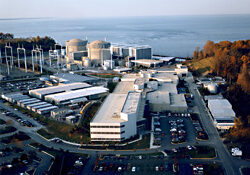Neo-Nazi previously implicated in plot to attack nuclear plants now arrested for planning grid sabotage around Baltimore

As reported by the Washington Post, in an article entitled “Duo accused of neo-Nazi plot to target Maryland power stations: Atomwaffen founder Brandon Russell and Sarah Clendaniel allegedly sought to attack substations around Baltimore,” white supremacists are again implicated in playing with radioactive fire.
The article reports:
Russell, a former Florida National Guard member, is the founder of the neo-Nazi group Atomwaffen Division, which attempted to use violent attacks to spark a race war in the United States. Experts say the group, while small, is dangerous because of its influence on the broader far-right movement to eschew politics and spill blood…
A former Atomwaffen member named Devon Arthurs, who lived with Russell in Tampa, killed two of their roommates in 2017 and subsequently told authorities they had been planning attacks on U.S. nuclear plants and power lines.
(emphasis added)
See an October 25, 2020 post about Atomwaffen Division’s prior plot to attack nuclear power plants. (Atomwaffen means nuclear weapons in German.)
The Washington Post article reports:
According to prosecutors, their plan was to attack with gunfire five substations that serve the Baltimore area. In conversations about the plot, according to court documents, Clendaniel “described how there was a ‘ring’ around Baltimore and if they hit a number of them all in the same day, they ‘would completely destroy this whole city.”…
Special Agent in Charge Thomas J. Sobocinski of the FBI field office in Baltimore said Clendaniel and Russell conspired to inflict “maximum harm” to the power grid.
“The accused were not just talking, but taking steps to fulfill their threats and further their extremist goals,” Sobocinski said…
According to prosecutors, they used open-source information on the national infrastructure grid to pick five electrical substations around Baltimore that would, if attacked on the same day, create a “cascading failure” in the system.
“Their actions threatened the electricity and heat of our homes, hospitals and businesses,” Sobocinski said.
But a grid failure in Maryland would also carry nuclear power risks. For example, Exelon’s twin reactors at Calvert Cliffs nuclear power plant in Lusby, Maryland on the shore of Chesapeake Bay (pictured above) depend on the electric grid for its primary electricity supply to run safety and cooling systems needed to prevent core meltdowns, as well as to prevent overheating of highly radioactive waste indoor wet storage pools. There are backup emergency diesel generators (EDGs) on site, in case the grid is inoperable. But EDGs are themselves notoriously unreliable, and will eventually run out of fuel unless resupplied.
Support Beyond Nuclear
Help to ensure a safer, greener and more just world for all

